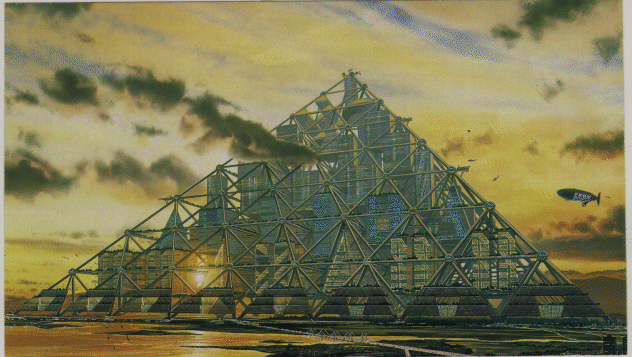- Shimizu Mega-City Pyramid
thumb|300px|The_Pyramid_City_Arcology orMegacity as featured on the Discovery Channel's "Extreme Engineering " programs.]The Shimizu TRY 2004 Mega-City Pyramid is a proposed project for construction of a massive pyramid over
Tokyo Bay inJapan . The structure would be 12 times higher than the Great Pyramid atGiza , and would house 750,000 people. If built, it will be the largest man-made structure on Earth. The structure would be 2,004meter s (6,575 feet) high and would answer Tokyo's increasing lack of space.The proposed structure is so large that it cannot be built with currently available materials, due to their weight. The design relies on the future availability of super-strong lightweight materials based on
carbon nanotube s.Dimensions
Perimeter of the foundation above ground would be 2,000 meters. Area of the foundation is 8 square kilometres. Infrastructure is an area of approximately 25 km². Gross building area is about 88 km² of facilities layers:
*Layers 1 to 4: residential, offices, etc.
*Layers 5 to 8: research, leisure, etc.The height of each layer is 250.5 m (for 8 layers, the pyramid is 2,004 m tall).The pyramid structure would be composed of 55 smaller pyramids stacked five high. Each of these smaller pyramids would be about the size of the
Luxor Hotel in Las Vegas.Usage
The building would be zoned into residential, commercial and leisure areas. 50 km² would be given over to some 240,000 housing units, enough for 750,000 people. Each building would have its own energy resources (sun and wind). 24 km² would be assigned to offices and commercial facilities intended to employ 800,000 people. The remaining 14 km² would be used for research and leisure purposes.
Materials and construction process
First, the pyramid's foundation would be formed by 36 piers made of special concrete.
Because the seismically active
Pacific Ring of Fire cuts right throughJapan , the external structure of the pyramid would be an open network of megatrusses, supporting struts made from carbon nanotubes to allow the pyramid to stand against and let through high winds, and surviveearthquakes andtsunami s.The trusses would be coated with photovoltaic film to convert sunlight into electricity and help power the city.
Large robots would assemble the truss structure, and air bladders would be used to elevate trusses above the first layer using a construction system proposed by Italian architect
Dante Bini . Spheroid nodes at the connections between trusses would provide structural support and serve as transfer points for travellers.Interior traffic and buildings
Transportation within the city would be provided by accelerating walkways, inclined elevators, and a personal rapid transit system where individual driverless pods would travel within the trusses.
Housing and office space would be provided by 80-story high skyscrapers suspended from above and below, and attached to the pyramid's supporting structure with nanotube cables.
ee also
*
Arcology
*Megacity
*Sky City 1000 External links
* [http://dsc.discovery.com/convergence/engineering/pyramidcity/interactive/interactive.html Discovery Channel's Extreme Engineering: City in a Pyramid]
* [http://www.binisystems.com/try.html Home Page for Bini Systems' proposed pneumatic construction method]
Wikimedia Foundation. 2010.

